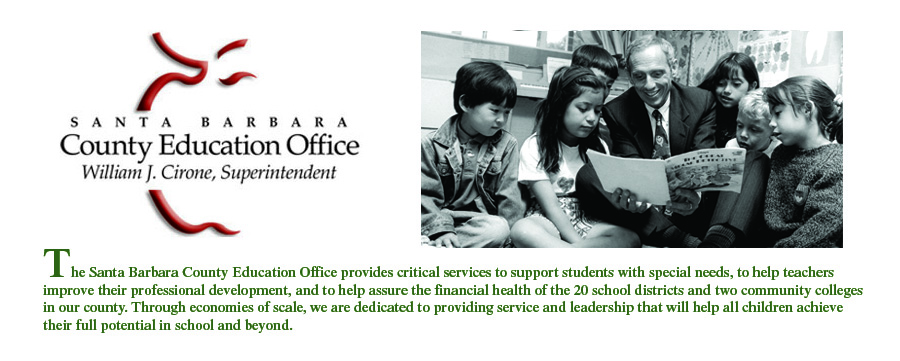Newspaper Column
May 22, 2013
By Bill Cirone, Santa Barbara County Superintendent of Schools
As members of the Class of 2013 prepare for their high school graduation ceremonies across California, hundreds of thousands of them are also preparing to enroll in one of the state’s 112 community colleges.
Local students don’t have to look far to find two great choices — Santa Barbara City College and Allan Hancock College. Both have long been jewels of the state system, and they recently received overwhelming confirmation of their lofty status.
City College was named one of two top community colleges in the country by the Aspen Institute, which cited SBCC’s outstanding achievement in student learning outcomes, degree completion, labor-market success (students securing good jobs after college), and facilitating the success of minority and low-income students.
Hancock is regularly ranked as one of the five best community colleges in California and one of the top 120 in the nation. This spring, it got a huge vote of confidence when it received the largest gift in its history — nearly $12 million — in a bequest from the late Patricia J. Boyd, a former faculty member.
These high-profile affirmations are important, and well deserved. The public may be tempted to take this excellence for granted — but it doesn’t come easily. Faculty members and administrators work every day to serve their students and the larger public, and students know it. Nearly 21,000 of them enrolled at Hancock last year, and nearly 27,000 at City College. They may be planning to get an associate’s degree in one of the many specialties the two colleges offer, transfer later to a four-year college or university, upgrade their professional skills, or retrain themselves in mid-life for another career. Perhaps they’re studying purely for personal enrichment.
Students of all ages and life experiences find a wide range of degree and certificate programs, outstanding faculty, impressive facilities, and great support services. Both schools can boast of their students’ career successes and excellent acceptance rates to four-year universities, and they can point to alumni who have achieved national and international success.
Two former Hancock students, for example, were prominent at this year’s Academy Awards ceremony — best-actress nominee Jessica Chastain and Oscar winner Mark Andrews. Oscar winners Kathy Bates and Robin Williams and Tony award-winner Boyd Gaines are also alumni.
Other examples of successful Hancock alumni include the late Admiral Owen Siler, international business executive Michael Henry, retired Major League pitcher Bryn Smith, the late artist Milford Zornes, retired NBA player Mike Bratz, and NFL coach Gunther Cunningham.
On its roster of famous graduates, City College can list two winners of the MacArthur Foundation’s “genius grants” — Dr. Angela Belcher, now an MIT professor and an authority in nanotechnology, and Dr. Yoky Matsuoka, a technology executive and an authority in neurorobotics — as well as World Series-winning pitcher Jesse Orosco and operatic tenor Eduardo Villa.
With more than 2.4 million students, the California Community Colleges are the largest system of higher education in the United States. They educate 80 percent of our state’s firefighters, law enforcement personnel, and emergency medical technicians, and 70 percent of our nurses.
Santa Barbara County’s two community colleges haven’t achieved this excellence alone. They rely on community partners — businesses, individuals, and nonprofit agencies — for raising money, providing expertise, and giving advice on how to shape programs that will make their graduates’ skills relevant in the marketplace.
This level of excellence is a further testament to the amount and importance of community support received by local schools. Congratulations to all the administrators, teachers, support staff, students, and community members who make SBCC and Allan Hancock two crown jewels in our national community college system.
